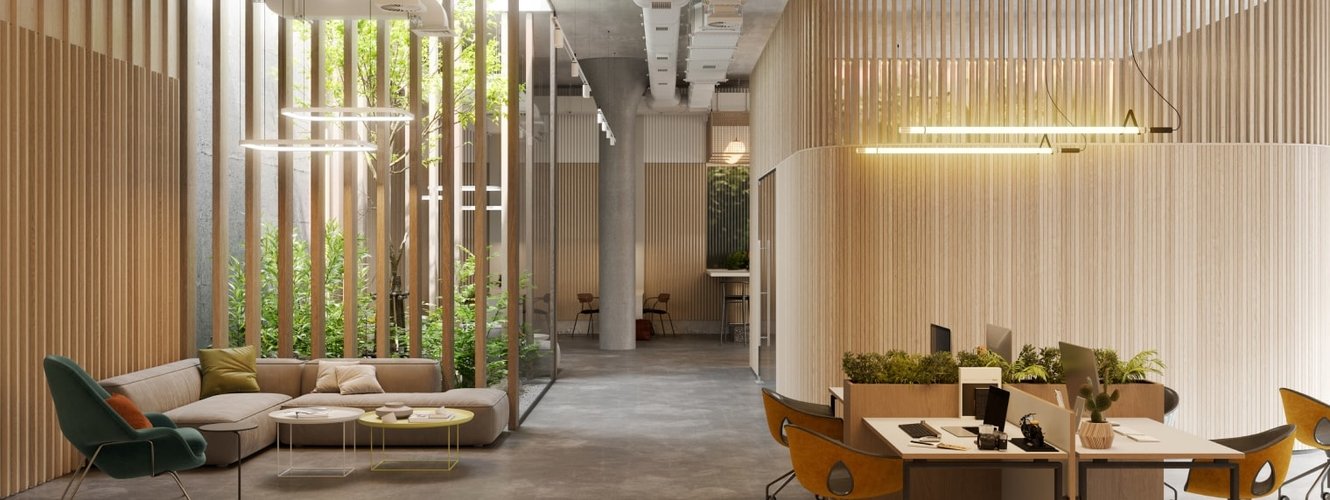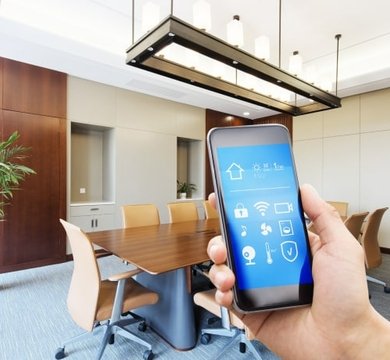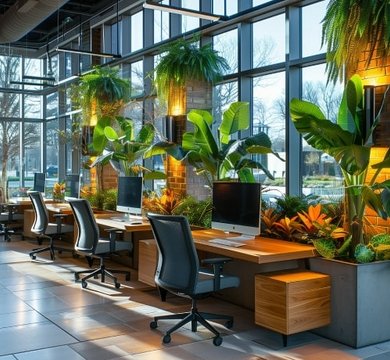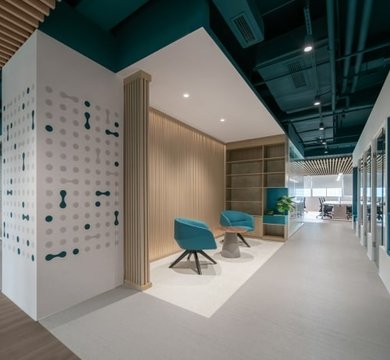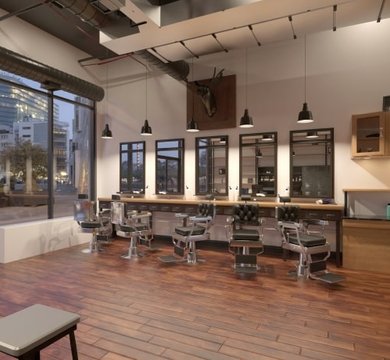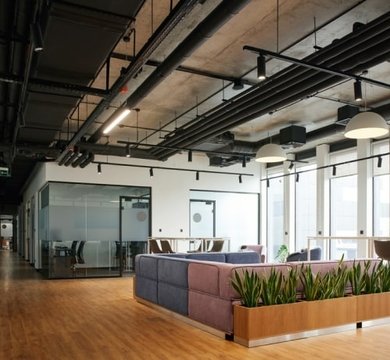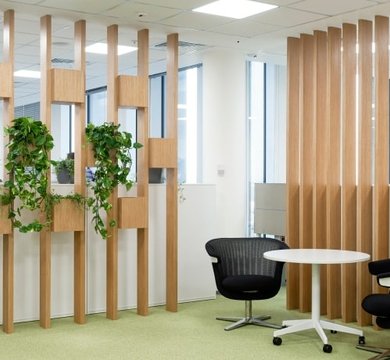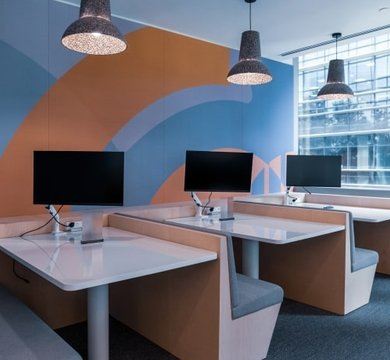When specifying the materials to use in an office renovation, there’s a myriad of choices. While glass and steel may have characterised the 1980s – think Richard Rogers’ Lloyds Building – and concrete leaves people divided, one material has stood the test time. Wood.
Wood office design is one of the most enduring concepts in our industry. Rather than be informed by manufacturing advances, technology or fashion, it is a direct reflection of nature. As a result, you’ll be creating a warm and inviting workspace every time you use wood.
The Benefits of Wood in Office Design
Wood is easy-on-they eye and longer lasting than pretty much any other material in the workplace. And did we mention its superior sustainability credentials?
Natural Aesthetics and Warmth
Every length, cross section or piece of wood has its own grain, tone and pattern. It’s this uniqueness that makes wood office design an exciting prospect.
Each species of tree will yield a different raw material, without the need for painting or staining. From the rich red-brown of mahogany and the almost black tones of wenge, to the blonde qualities of white ash and the golden warmth of maple, wood has a natural beauty that can’t be matched.
Unlike the coldness of steel and glass or the low-grade feel of laminate and plastic, a predominately wood office design will feel welcoming and tactile.
Durability and Longevity
When treated and installed properly, wood is one of the most long-lasting materials you can specify. It can be used in a variety of environments, can withstand heavy wear and tear, and will usually outlast several workforces.
There’s also the ability to sand wood back and retreat when there is superficial wear, and even repaint items of furniture for a completely new look. Wood’s durability makes it a highly-sustainable choice and a wood office design can be a shrewd long-term investment.
Sustainability and Eco-Friendly Choices
Wood is a renewable, sustainable material but just buying wood doesn’t mean you can go and polish your eco halo. The kindest choice is reuse and repurpose current wood items, which is fine for small scale revamps.
The next best option is to specify recycled or reclaimed wood but we know that’s not always possible when creating a wood office design with very specific client requests or within challenging environments.
More comprehensive renovations and fit out projects may require the use of ‘virgin woods’ – wood that comes direct from the forest. It’s important to look for a Forest Stewardship Council or FSC label, and air miles can be reduced by opting for locally-produced timber.
Best Practices in Wood Office Design
Can you ever have too much wood in the workplace? Potentially! A considered approach will avoid any space looking like a Finnish sauna, while delivering on all aspects of the client’s brief.
Strategic Use of Wood Elements
Almost every office has an element of wood in its design or finish. How many you include and how widely the material is used will determine the impact.
The most familiar application is probably wood flooring. This can take the guise of wood blocks (parquet style) or timber planks laid in either a random, herringbone or chevron pattern. When paired with painted walls and ceilings, the wood is less intrusive and more harmonious.
Wood panelling is a historic way of covering walls, with trends morphing between full coverage, partial coverage up to a dado rail, decorative mouldings and timber slats.
Wooden furniture has become less common over the years, with ‘off the peg’ items finished with a laminate becoming more popular. Look in any boardroom or study, however, and you’ll find it’s the solid wood items that are the oldest and give the space the most character.
It’s possible to create a wood office design using less familiar elements. Wood can be applied to ceilings in the form of panelling or timber slats, creating an unusual focal point. The versatility of wood veneer should not be overlooked either. This mouldable material can be used to clad curved reception desks or line alcoves and architectural archways.
Combining Wood with Modern Design
If you’re worried about wood overkill, it’s possible to blend a wood office design with other materials, colours and finishes. Simple pairings include a glass-topped boardroom table with wooden legs, an Eames Lounge chair in leather with plywood shell detail and raw concrete walls with wooden shelves.
Office Wooden Wall Design
Our office refurb solutions often feature wall designs with wood, as the natural warmth and versatility of the material provides a great base and many advantages.
Enhancing Interiors with Wooden Walls
While wood panelling was frequently used to hide imperfections, today it is used for more decorative effects. A mid-century ambience can be created by opting for an office wooden wall design with full panelling on every side. It’s a design feature we explore in this blog, drawing parallels with the TV show Mad Men and its use of American walnut, cedar, teak, rosewood and bronze tulipwood.
Flat panels of wood can be swapped out for tongue and groove, or a wood ‘lite’ approach achieved with delicate mouldings – Shaker or Wainscoting are popular. Very ‘of the moment’ are timber slats. These can be applied vertically or horizontally, and can even incorporate LED lights for dramatic effect.
When incorporating wall designs with wood, we often choose to create a feature wall or confine the detail to one space. It’s also possible to apply wood to structural columns – something that can really ‘tie’ an interior theme together, especially if it runs across multiple floors.
Acoustic Benefits
Choose the right density of wood and it can have fantastic acoustic properties. The lower density of the material, the better soundproofing it provides against airborne noise. Pine and spruce absorb sound and vibrations as they are among the most porous of wood species. Plywood, medium-density fibreboard (MDF) and other engineered woods can also block or absorb sound.
Customization and Branding
Although wood will be an interesting enough feature on its own, thanks to its patina and grain, wall designs with wood may need personalising in corporate settings. At a base level, wood can be painted to match a company’s livery.
Acrylic and metal letters/logos can also be applied to wooden feature walls, either fitted flush or stud mounted. More advanced customization techniques include engraving and pyrography (the latter is the art of burning logos into wood).
Wood Office Design Ideas
The size, species and colour of wood used will affect the final theme and feel. Here are some suggestions:
- Plywood and fibreboard have crossed over from raw building materials to on-trend finishes. For an industrial, urban feel, specify plywood or fibreboard kitchen cabinets.
- Shelving made out of reclaimed scaffolding planks are not only sustainable but they can lend a room urban style too.
- If you’re worried about a wood office design looking like a 1970s forest cabin, consider a lime-washed or white-washed wood finish.
- Stacked timber sleepers can make good solid internal walls and partitions, with plenty of character and tactile appeal.
- Painting timber slats black and pairing them with white walls is a modern way to create a classic monochrome look.
- A hint of timber can be added to an office by choosing wooden light shades. Bending and steaming strips of ash, oak, cherry, birch, maple and walnut can result in spectacular pendant lights.
- For an old-school, traditional feel, opt for dark woods, such as cherry, mahogany and wenge.
Case Studies
MPL’s office design services have taken us across the country since the 1990s and there has always been a recurring element – wood. Here are three projects where timber has played a starring role.
Successful Wood Office Design Implementations
Kao Data
Painted timber slats were a hallmark at Kao Data – a 3,500 sq ft data centre we rebranded in Slough. Timber slats were used to great effect in the reception, painted different shades of corporate green to match the fin architectural details seen on the outside of the vast building.
The Acorn Group
A number of different timber aspects were incorporated in our fit out for The Acorn Group in Bromley. The most striking is the bespoke timber surround that sits over the main reception desk. Elsewhere are timber slat feature walls and a wood panel partition.
Maran Shipping
Our client Maran Shipping wanted a boardroom that was luxurious and classic. To achieve this look, MPL specified fine Italian veneered panels and matching furniture in a dark mahogany finish.
Conclusion
Timber is one of the most sustainable and durable sources we have to work with, so it makes sense to explore more wood office design plans. It’s a great material to specify when commissioning bespoke items, as it can be cut and shaped to fit any space. Add more wood to your workplace and you’ll banish a sterile office to the past and create a long-lasting, yet classic, interior design for the future.

